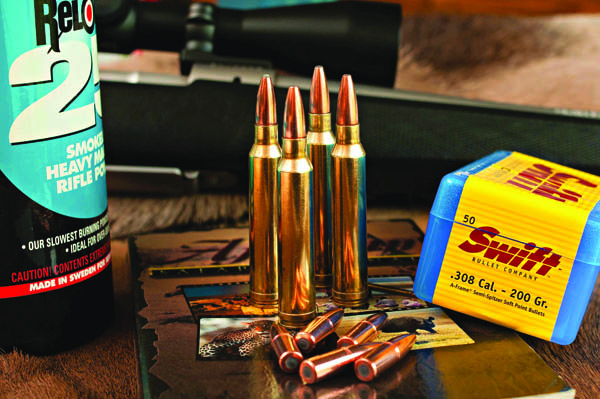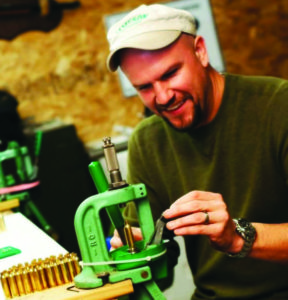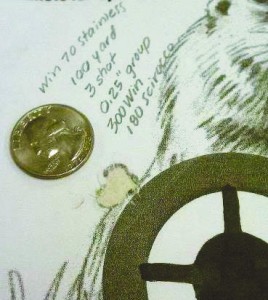

When it comes to reloading ammo, the .300 Win. Mag. can be tailored to take anything from whitetails to African plains game.
If you’re like me, you are constantly asking questions of other experienced handloaders.
Early on I learned that, when you ask a group of 10 handloaders a question, you’re likely to get at least a dozen answers, usually more. The ensuing debate is like an elixir for those of us who thirst for knowledge.
This time there was no group discussion, but I did have the ear of Phil Massaro, owner of Massaro Ballistic Laboratories.
Phil custom loads cartridges for the specific game and conditions in which his clients will be hunting. He’s not only a ballistician, but also an avid hunter who has taken game across North America and Africa. In short, he really knows his stuff.
Our conversation began with me asking why we Americans tend to carry what many consider to be too much gun, especially for whitetail deer.
With a laugh, Phil suggested that we were going to get along just fine. Then he answered, “Advancements in bullet construction over the past 30 years have really transformed the capabilities of what were once considered lesser cartridges. The old Elmer Keith versus Jack O'Connor arguments need to be revised. Bonded core, partitioned and mono-metal bullets have changed the game.”
He went on to explain that the old cup-and-core bullets—bullets that have a copper “cup” and a lead “core,” no bonding, partitions or anything to hold them together when they start to deform—wouldn’t remain intact like today’s bonded and partitioned projectiles.
Back then, a .270 was considered marginal for elk. Phil pointed out that now your deer rifle can take down an elk when loaded with a good bullet like a Swift A-Frame or the Barnes TSX.
When asked what he carries, Phil didn’t hesitate.
“The .300 Winchester Magnum,” he said—and by the end of our discussion about too much gun and advancement in bullet technology, my jaw was on the floor.
Load It Down?

Of course I wasn’t surprised when he said that he could load it up for big game. That’s what the round was developed for. That he could “load it down” for a teenager to shoot whitetail and not walk away bruised and battered was a bit of a shock.
When hunting game on the African plains, Phil will likely have his Winchester Model 70 Classic loaded with a 200-grain Swift A-Frame backed by 75 grains of Reloder-25 that will push it to 2,750 fps. He also developed a load to duplicate the specifications of the .300 H&H, with a 220-grain Hornady Interlock backed by 53 grains of IMR4064 and zipping along at 2,400 fps. His all-around big-game load is 180-grain Swift Scirocco II with 73 grains of Reloder-19, which zings along at 2,900 fps.
Of course, we all know the .300 Win. Mag. is a great cartridge for elk, moose and bear, but I was really interested in the lower end of the spectrum. You see, I am as focused on developing new hunters as I am bagging my own game. If we want women and teens to embrace our hunting lifestyle, we don’t want them beat up by an unnecessarily heavy-recoiling rifle.
Too much gun can turn a would-be hunter into a “not-gonna-be” hunter. Even those committed to the sport can have issues.
“The recoil from full-house factory loads can be a detriment to new shooters, for sure. A flinch developed early on, especially from bench-rest shooting, can be very difficult to overcome,” Phil explains.
He also pointed out that using less gun can be an issue with an inexperienced hunter.
“The 6mm and .22 centerfires are often found in the hands of beginners. But I think that, due to the lighter bullet weights in these calibers, they are best left in the hands of an experienced hunter, one who is more willing to turn down a questionable shot and wait for the broadside shot that will kill effectively and humanely,” he says.
While I understand his point, I am not totally on-board with Phil’s assertion. It’s not as though we toss a rifle to a new hunter and say, “bring home some venison.” A new hunter is likely to be in the field with someone more experienced who is going to coach them.
Phil could tell I was unconvinced that the .300 Win. Mag. still wasn’t too much gun for a new hunter, especially one of small stature. So he went even further in his reasoning.
“Even a 10-percent reduction in velocity can result in a perceived recoil reduction of half,” he says.
Half? Really?

Yup. Chock a 150-grain bullet into a case with 28 grains of SR4759, and you are pushing it 2,050 fps. That’s close to .30-30 performance. A 165-grain projectile loaded in front of 27 grains of SR4759 nets you about 1,900 fps, while a 180-grain bullet with 31 grains of IMR 4198 lands in the 1,850 fps range.
Even at these velocities, though, the cartridges maintain the legendary accuracy the .300 Win. Mag. is known for—and it’s more than enough to kill a whitetail at 150 yards, and without punishing a smaller person.
“The 300 Win. Mag. is simply one of the most flexible cartridges for North America and African plains game,” Phil says.
I have to say his conversation made me a convert. When you can get a cartridge to exhibit this kind of breadth and depth then you definitely have a winner that is perfect for the game being hunted and the shooter doing the hunting.
Editor's Note: This article originally appeared in the Oct. 21, 2013 edition of Gun Digest the Magazine.

Next Step: Get your FREE Printable Target Pack
Enhance your shooting precision with our 62 MOA Targets, perfect for rifles and handguns. Crafted in collaboration with Storm Tactical for accuracy and versatility.
Subscribe to the Gun Digest email newsletter and get your downloadable target pack sent straight to your inbox. Stay updated with the latest firearms info in the industry.

![Best Concealed Carry Guns In 2025 [Field Tested] Wilson Combat EDC X9S 1](https://gundigest.com/wp-content/uploads/Wilson-Combat-EDC-X9S-1-324x160.jpg)


![Best 9mm Carbine: Affordable PCCs [Tested] Ruger Carbine Shooting](https://gundigest.com/wp-content/uploads/Ruger-Carbine-Shooting-100x70.jpg)
![Best AR-15: Top Options Available Today [Field Tested] Harrington and Richardson PSA XM177E2 feature](https://gundigest.com/wp-content/uploads/Harrington-and-Richardson-PSA-XM177E2-feature-100x70.jpg)

I have all 3
30-06 / 308 win and 300 Win Mag
mainly I consider the 308 Win equals but the 30-06 due extra length can handle the 200 gr Flatbase bullet a little better than the 308 Win. I draw the line at 180gr with the 308 Win.
my 300 win mag is reserved when the extra range is needed 400 to 500 yards shots common on moose hunting here in Alaska.
but when the range is shorter like on my canoe trips the handy 308 Win with 165gr Fail Safe handholds is often in my possession.
.308 Winchester 180 gr
2593 fps
@100 yards 2,337 ft lbs.
.300 Win Mag 180 gr
3060 fps
@100 yards 3,279 ft lbs. (29% over .308)
Taking game inside 200 yards, with Bonded core, I would think the .308 Winchester would do the trick every time in N. America making the .300 win mag overkill.
Don’t get me wrong, I would love to have a 300 win mag as my next rifle. Just don’t think it’s “better” at taking large game than the .308 or 30-06. It does sound more fun to reload.